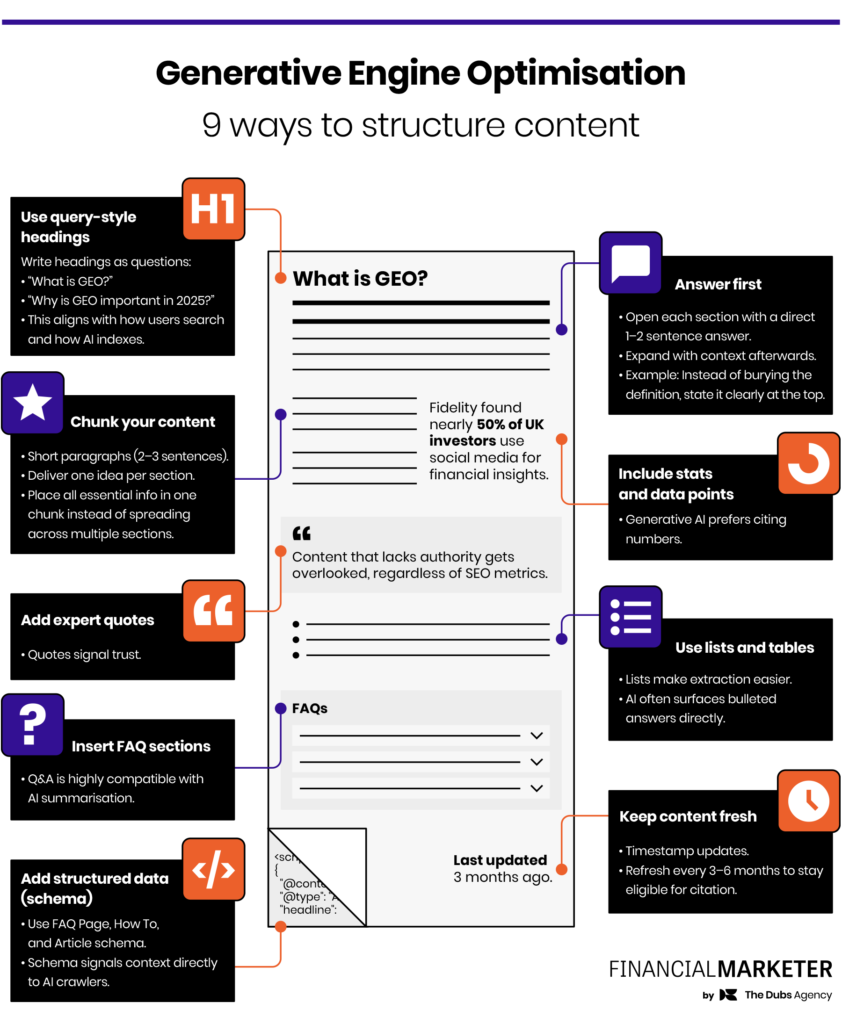Generative Engine Optimisation (GEO) is the process of shaping content so AI search engines can easily understand, trust, and cite it in responses. To rank in generative search, structure your content with direct answers, query-based headings, concise chunks, authoritative stats, and clear schema markup.
What is Generative Engine Optimisation?
Generative Engine Optimisation (GEO) is a content strategy designed for AI-powered search engines like ChatGPT, Google SGE, and Perplexity. Unlike traditional SEO, which focuses on rankings in search results, GEO focuses on visibility inside AI-generated answers.
-
Seer Interactive reports brands that applied GEO saw 40% more inclusion in generative search responses
Why does GEO matter?
-
AI is becoming the default search tool: Gartner predicts 70% of search traffic will be powered by generative AI by 2028.
-
Generative engines don’t just rank pages, they summarise, paraphrase, and cite.
-
If your content isn’t structured to be machine-readable, it risks invisibility.
As Mahesh Chand says, in this C# Corner article
“ If SEO was about keywords and backlinks, GEO is about stats, quotes, and citations.”
So how do generative engines process content?
AI engines:
-
Retrieve relevant content chunks.
-
Summarise into natural language.
-
Cite or paraphrase trusted sources.
Dense, unstructured articles get skipped. Structured, chunked answers are easier to retrieve and cite.

Example outline for GEO-optimised content
-
Quick answer
-
What is GEO?
-
Why does it matter?
-
How generative engines work
-
GEO playbook (9 structural rules)
-
Example Q&A / FAQ section
-
Tools to implement GEO (schema generators, content audits)
-
Measurement and KPIs
-
References and sources
How to measure GEO success
Traditional SEO metrics (rankings, CTR) are not enough. New GEO metrics include:
-
Share of Answer (SoA): % of queries where your content is cited.
-
Citation impressions: number of times your content is pulled into AI answers.
-
Engine coverage: how many AI platforms (ChatGPT, Gemini, Perplexity) cite you.
-
Sentiment of citation: positive, neutral, or critical context.
In summary
Generative engines are rewriting the rules of visibility. To succeed:
-
Start each section with a clear, direct answer.
-
Structure content for machines with Q&A, lists, and schema.
-
Signal authority with stats, quotes, and sources.
-
Track new GEO metrics, not just old SEO ones.
The brands that embrace GEO now will own the generative search landscape of tomorrow.
FAQ: Generative Engine Optimisation (GEO)
1: What is Generative Engine Optimisation?
A: Generative Engine Optimisation (GEO) is the process of structuring content so AI search engines can easily understand, summarise, and cite it in their responses.
2: How is GEO different from SEO?
A: SEO focuses on ranking pages in search engines like Google. GEO focuses on visibility inside AI-generated answers.
3: Why is GEO important in 2025?
A: Gartner predicts 70% of search traffic will be powered by generative AI by 2028. Content not optimised for GEO risks being invisible.
4: What type of content do generative engines prefer?
A: Engines prefer short, well-structured chunks, lists, tables, statistics, and Q&A formats over long narrative text.
5: How can I make my content AI-friendly?
A: Use query-style headings, answer first in each section, add stats and expert quotes, break up content with lists, and embed FAQ sections.
6: Do expert quotes help with GEO?
A: Yes. Quotes signal authority. AI engines are more likely to cite trusted expert opinions alongside statistics.
7: What role does structured data play in GEO?
A: Schema markup (FAQPage, HowTo, Article) helps engines interpret your content and boosts its chance of being cited.
8: How often should I refresh content for GEO?
A: Refresh and timestamp content every 3–6 months to maintain freshness and trustworthiness for AI citations.
9: What are the main GEO success metrics?
A: Share of Answer (SoA), citation impressions, engine coverage across platforms, and sentiment of citation.
10: Can GEO replace SEO?
A: No. SEO remains vital for traditional search visibility, but GEO is an essential layer to ensure inclusion in AI-driven search results.
[For full disclosure: The author used Perplexity to research this article while the podcast was created using ElevenLabs]










